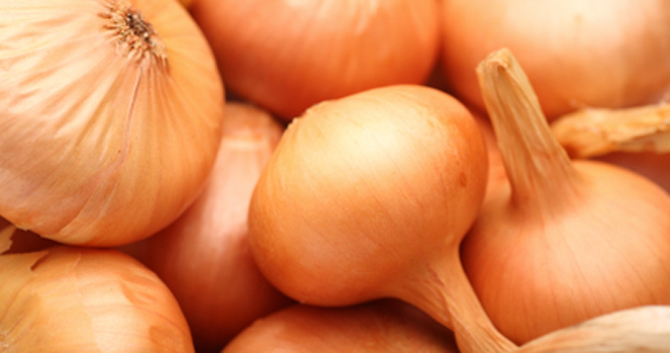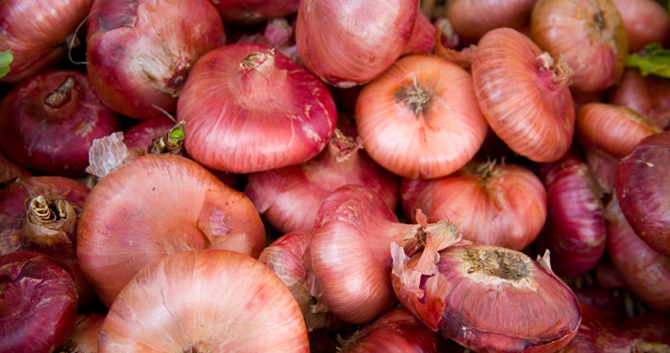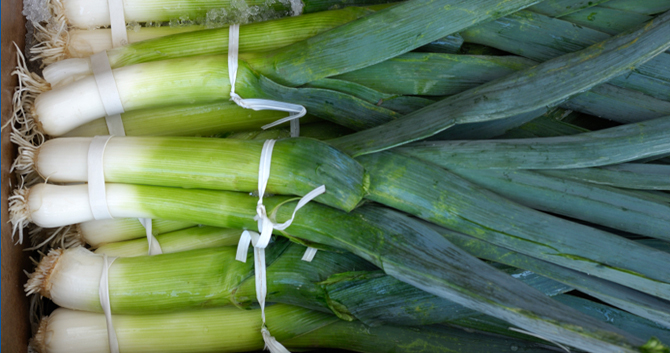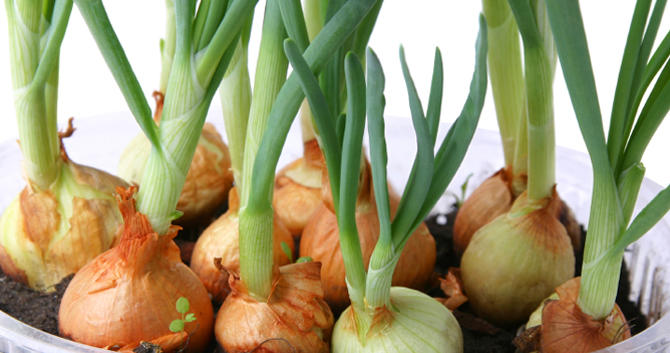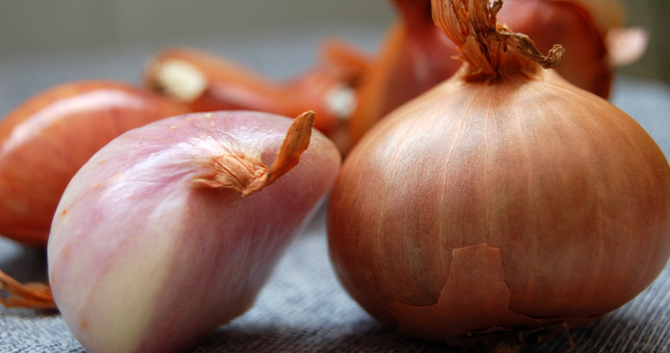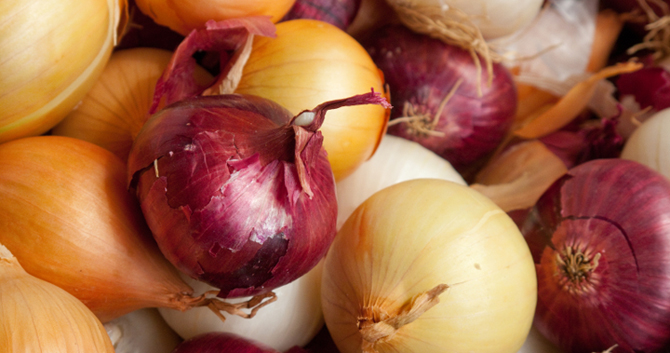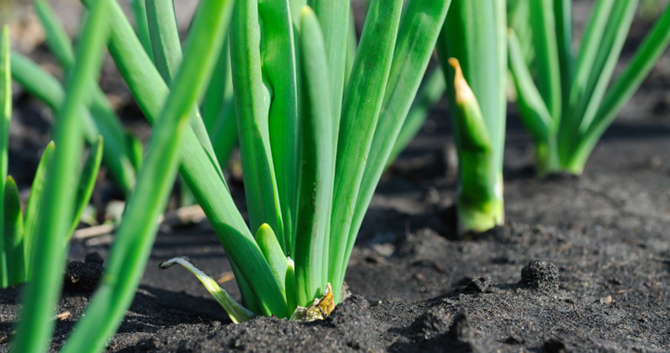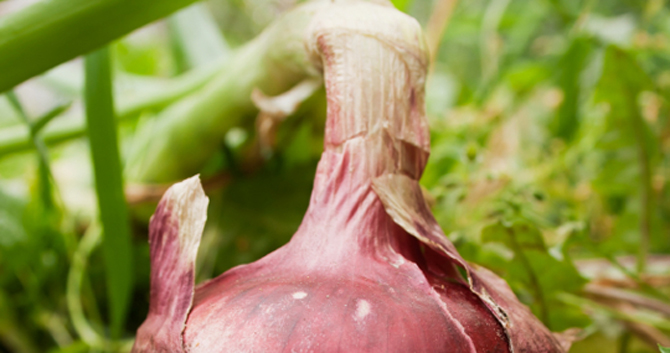Onions are an essential supply for the kitchen pantry. These aromatic vegetables are prized for their versatility and their ability to add depth of flavor and complexity to nearly any recipe.
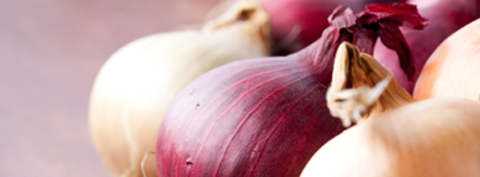 All types of onions are easy to grow, requiring little attention.
All types of onions are easy to grow, requiring little attention.
Growing onions creates an air of anticipation – since you can’t see what’s going on underground, you’ll be kept in suspense, wondering and guessing how your crop is doing, as the bulbs begin to form and eventually break the surface of the soil. When the day comes to harvest your onions, it’s better than opening a present! But of course the real magic happens when they're cooked, which mellows their flavors and coaxes out their natural sweetness.
Native to the Asia and the Middle East, onions have likely been a part of the human diet as far back as history can trace. Their rich flavor and long storage properties made them key to survival in lean seasons, and earned them to a prominent place in many ancient cultures—as well as the kitchen.
Onions are members of the lily family. With many layers in one bulb, their common name “onion” originated from the Latin word Unio, which means unity or oneness. The bulbs are actually the food source the plant uses to grow green shoots the following year.
Types of onions:
Onions, leeks, scallions, chives, garlic, and shallots are all members of the genus Allium. There are as many types to choose from as there are layers to their bulbs, from small to large, sweet to pungent, and delicate to assertive. Some types are grown for their large, flavorful bulbs and others for their delicate, mild shoots.
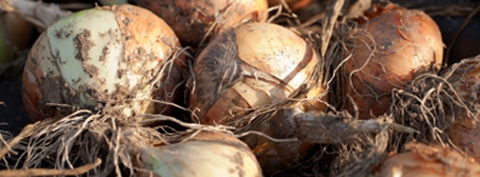 Spanish onions are larger, sweeter, and milder than yellow or red storage onions.
Spanish onions are larger, sweeter, and milder than yellow or red storage onions.
Those grown for their bulbs come in a variety of shapes, sizes and colors, but are usually grouped according to flavor – sweet or pungent. Sweet varieties are higher in sugar, lower in sulfur, and higher in moisture content than pungent onions. Some of the most popular bulb onions include:
- Storage onions are high in sulfur and have a complex, assertive flavor that mellows when cooked. These all-purpose globe shaped bulbs can be used in most any recipe that calls for onions. White varieties have a tangy flavor that’s prized in Latin cultures. Yellow and red varieties tend to be stronger and more pungent.
- Spanish onions are larger, sweeter, and milder than yellow or red storage onions. Available in yellow, white, and red varieties, they are another all-purpose onion that’s extremely versatile.
- Sweet onions, also known as fresh onions, spring onions, or summer onions, are sweet and mild. They have twice the sugar content of storage onions, are higher in moisture and lower in sulfur compounds. As a result, sweet onion varieties like Bermuda, Walla Walls, and Vidalia are as delicious eaten raw as they are when cooked.
Don’t overlook the smaller onions when planning your garden. These specialty types are sometimes more difficult to get in the supermarket, so growing them yourself ensures a ready supply for roasting or grilling, kabobs or side dishes.
Pearl onions also known as button onions or baby onions, are sweet and mild. Only about one inch in diameter, they’re used as garnishes and typically pickled, creamed, glazed, or roasted.
Cipollini onions: Translated from Italian, the name literally means “small onion”. These tiny, flat onions are one to two inches in diameter with thin skins and high sugar content. Uncooked they’re extremely bittersweet, but when roasted or grilled, the onions soften, the sugars concentrate and caramelize, and the flavors mellow.
Shallots look like garlic but taste like a sweet, mild onion. Traditionally used in French cuisine, they’re also popular in Asian cultures.
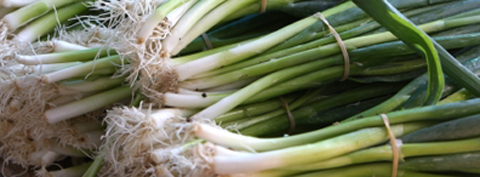 Scallions have a mild, grassy flavor that hints of spring.
Scallions have a mild, grassy flavor that hints of spring.
Green onion shoots have a distinctive, fresh onion flavor that comes through better from a home-garden harvest than anything you’ll find in the supermarket. Although all onions will have green leaves that spring from the bulbs, there are several types of onions cultivated specifically for their shoots rather than their bulbs.
Scallions, also known as green onions, bunching onions or Welsh onions, are actually the tops of immature bulb onions. They have a mild, grassy flavor that hints of spring. Scallion’s delicate flavor is best when used fresh, but they can be added at the end of cooking when the dish is being removed from the heat. Generally, the larger the scallion, the stronger the flavor.
Leeks look like large scallions with tightly wrapped, dark green leaves that gradually fade to white near the bulb. The white and light green parts have a mild flavor that tastes like a cross between a cucumber and an onion. The darker green part is tough, bland, and bitter—and usually discarded.
Ramps are wild leeks with an assertive, biting flavor that tastes like a cross between garlic and onions. Both the leaves and bulbs are edible and become mildly sweet when cooked.
Getting Started:
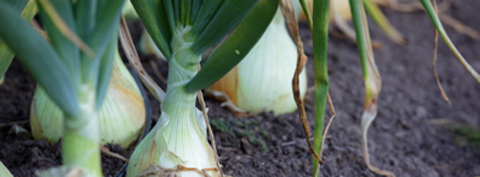 Sweet onions like Vidalia, Bermuda, and Walla Walla have twice the sugar content of storage onions.
Sweet onions like Vidalia, Bermuda, and Walla Walla have twice the sugar content of storage onions.
All onions are compact and easy to grow in containers or garden plots. They love cool weather and lots of sun. Select a spot to with 6 or more hours of sunlight, keeping in mind that the more light your plants receive, the larger the onions will grow.
Since onion bulbs develop underground, they need loose, fertile, well-drained soil. Be sure to prepare the site to a depth of 12 inches with compost-enriched soil. If planting in containers, the pot should be at least 10 inches deep and as wide as possible to give the bulbs plenty of room to grow.
Care Tips:
All types of onions are easy to grow and with a little attention and care, will reward you a bumper crop to enjoy grilled, roasted, fried or raw.
Planting:Don’t rush your onions into the ground – they like it cool but won’t tolerate cold. After danger of frost is past, set plants slightly deeper than they were growing in the pot (1-2 inches deep for unpotted bulbs) and space two to six inches apart, keeping in mind the mature diameter of the type you are planting. Grow rows of onions about 12” apart.
Leeks are unique in that they need to be planted in trenches about six inches deep. Cover the bulb and stem up to the point where the leaves open away from the stem, and as the plants grow taller, backfill the trench to keep the stem fully covered. This prevents the sunlight from turning the stems green and bitter, increasing the yield from your crop.
Watering:
All onions need abundant and consistent water to produce large, sweet, high quality bulbs or greens. You’ll need to apply about one inch each week, unless Mother Nature takes care of the task for you. Stop watering when the tops turn yellow or fall over; this is a sign that plants are mature and bulbs are ready to harvest.
Mulching:
Mulch around the plants to keep soil uniformly moist and free of weeds. Onions have shallow roots and their size and quality will suffer if weeds take hold and complete for moisture and nutrients. Avoid piling the mulch against the onion’s stems when it is first applied.
Fertilizing:
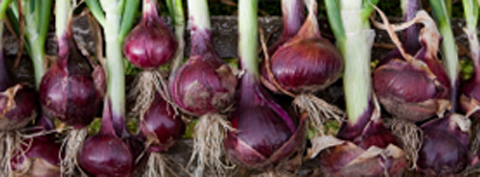 Red storage onions have a complex, assertive flavor that mellows when cooked.
Red storage onions have a complex, assertive flavor that mellows when cooked.
Onions respond well to fertilizing, and especially benefit at critical growing times. Three weeks after planting, when the tops are about six inches tall, a dose of fertilizer will encourage more top growth that will feed the bulb. Feed again when the bulbs begin to swell. Choose a balanced fertilizer recommended for vegetables, and apply according to package directions. Note that fertilizer products that include sulfate can make the onions taste stronger, so choose according to your preference.
Harvesting:
It is time to prepare for the bulb onion harvest when their tops have fallen over half way. The bulbs need to be cured before they can be dug. Accomplish this by gently pushing the tops the rest of the way down, leaving them attached to the bulbs. Leave them in the ground for a few days, then take a garden spade alongside the row and gently lift the onions from below—never pull by their tops. Shake and brush off excess dirt.
Leeks can be harvested at any time after they reach one inch in diameter and six inches tall. For best results, loosen the soil with a trowel, then ease and gently twist the leeks out of the ground.
Scallions may be harvested when the tops reach about 6 inches tall. Loosen the soil around the plant, and then carefully and gently pull up the scallion with its bulb.
Companion Plants:
Onions grow well with most other plants, and actually improve the health of roses when planted nearby, by deterring aphids and moles.
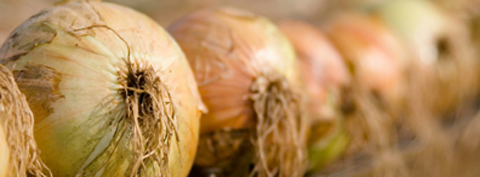 Storage onions must be dried before storing for the winter.
Storage onions must be dried before storing for the winter.
Strawberries share space particularly well with onions, helping keep the soil shaded and moist.
Conversely, onions stunt the growth of beans and peas.

